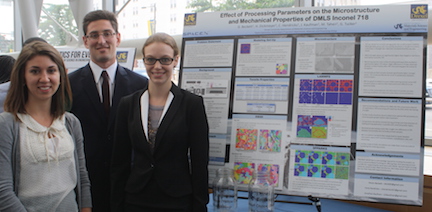
The Senior Design course sequence (MATE 491, 492, and 493) is the most important challenge of the senior year. This three-term capstone sequence is intended to simulate a professional research and learning environment. Students benefit from the sequence in two ways: it provides a forum to communicate their ideas and results to the faculty and their peers, and it gives them an opportunity to demonstrate, in an integrated fashion, the skills and knowledge they have acquired during their undergraduate education. Substantial interaction between students, faculty, and industry/government institutions is an integral part of the experience.
The course is designated as writing intensive in the fall and spring term for BS students and in all three terms for thesis option BS/MS students. Students in the accelerated BS/MS program only complete senior design if they are pursuing the non-thesis BS/MS option. BS/MS students electing to write and defend a thesis do so in lieu of the senior design sequence.
By the beginning of the fall term students are expected to have selected a project, a faculty advisor and graduate student mentor, and to have formed or joined a team.
Senior Design Course Structure
All seniors (including BS/MS students) are required to meet with their advisor(s) on a regular basis to review progress, identify problem areas, and discuss and develop solutions. Each term, there are weekly class meetings at which students’ attendance is required. These meetings are in part organizational and informational meetings and progress reviews, and include topics such as:
- Laboratory safety
- Aspects of the design process - what makes a good project
- Job hunting and career selection
- Patents and intellectual property
- Professional skills: task and time management, teamwork, keeping a lab notebook, budget preparation, GANNT charts, etc.
- Research and library information resources
- Written reports (including Writing Center Peer Reader review) and oral presentations
- Economic, environmental, social, political, ethical, health & safety, manufacturability, and sustainability considerations
Senior Design Term by Term
Fall Term (2 Credits)
- Prepare and submit written pre-proposal for review and final approval
- Prepare and submit written risk and safety analysis for proposed work
- Develop and present design/project proposals and initial results to the materials faculty and peers, scored according to applicable ABET 1-7 criteria
Winter Term (3 Credits)
- Review fall term written and oral presentation evaluations
- Continue working on research/design problems
- Give oral and written progress reports to materials faculty, peers, and any external project supporters, scored according to applicable ABET 1-7 criteria
Spring Term (3 Credits)
- Review winter term written and oral presentation evaluations
- Continue working on research/design problems
- Prepare and present final oral reports and submit written final reports to the materials faculty, scored according to applicable ABET 1-7 criteria
Examples of Senior Design Projects
- PDFs of previous Senior Design quad charts can be viewed here.
Senior Design Support Opportunities
- More Information about becoming a Senior Design Supporter can be found here.